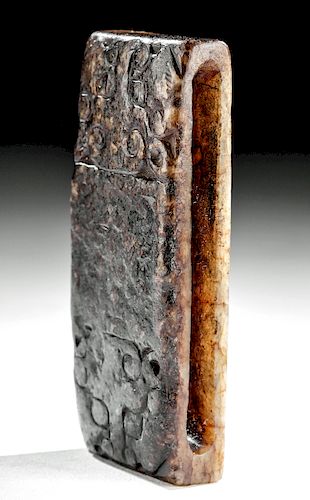Chinese Ming Dynasty Nephrite Scabbard Slide
Lot 185
About Seller
Artemis Gallery
686 S Taylor Ave, Ste 106
Louisville, CO 80027
United States
Selling antiquities, ancient and ethnographic art online since 1993, Artemis Gallery specializes in Classical Antiquities (Egyptian, Greek, Roman, Near Eastern), Asian, Pre-Columbian, African / Tribal / Oceanographic art. Our extensive inventory includes pottery, stone, metal, wood, glass and textil...Read more
Categories
Estimate:
$1,600 - $2,400
Absentee vs Live bid
Two ways to bid:
- Leave a max absentee bid and the platform will bid on your behalf up to your maximum bid during the live auction.
- Bid live during the auction and your bids will be submitted real-time to the auctioneer.
Bid Increments
| Price | Bid Increment |
|---|---|
| $0 | $25 |
| $300 | $50 |
| $1,000 | $100 |
| $2,000 | $250 |
| $5,000 | $500 |
| $10,000 | $1,000 |
| $20,000 | $2,500 |
| $50,000 | $5,000 |
| $100,000 | $10,000 |
| $200,000 | $20,000 |
About Auction
By Artemis Gallery
Jan 7, 2020
Set Reminder
2020-01-07 10:00:00
2020-01-07 10:00:00
America/New_York
Bidsquare
Bidsquare : VARIETY AUCTION - Antiquities / Ethnographic
https://www.bidsquare.com/auctions/artemis-gallery/variety-auction---antiquities-ethnographic-4787
Around the world & back in time - be amazed at the treasures you will find. Antiquities from Egypt, Greece, Italy and the Near East, Asian, Pre-Columbian, African / Tribal / Oceanic, Native American, Spanish Colonial, Russian Icons, Fine Art, much more! Artemis Gallery info@artemisgallery.com
Around the world & back in time - be amazed at the treasures you will find. Antiquities from Egypt, Greece, Italy and the Near East, Asian, Pre-Columbian, African / Tribal / Oceanic, Native American, Spanish Colonial, Russian Icons, Fine Art, much more! Artemis Gallery info@artemisgallery.com
- Lot Description
**Originally Listed At $800**
East Asia, China, probably Ming Dynasty, ca. 1368 to 1644 CE. A wide, handsome scabbard slide, made from a richly banded dark and light brown nephrite jade. On its face is a relief of two tiger faces, one facing outward from either end. The jade is very thin, demonstrating the skill of the artist who carved this piece. The scabbard slide was invented in the steppes of the southern Ural Mountains 2500 years ago, developed to manage the long iron equestrian sword. The scabbard slide was attached, using silk thread or a thin strip of metal, to a flat or ribbed part of the scabbard, facing away from the body and generally at the balance point. A belt, usually of leather, would go through the slide. Trousdale (1975) suggests that the scabbard slide was the sole device used for suspending a sword in China for six hundred years. The swords that are buried with these jade ornaments are ceremonial or presentation swords and belong to noblemen. Size: 2.75" W x 1.2" H (7 cm x 3 cm)
c.f. Trousdale, W. 1975. The Long Sword and Scabbard Slide in Asia. Smithsonian Contributions to Anthropology, No. 17.
Provenance: private Rhode Island, USA collection; purchased from the estate of a Massachusetts, USA collector in the 2000s
All items legal to buy/sell under U.S. Statute covering cultural patrimony Code 2600, CHAPTER 14, and are guaranteed to be as described or your money back.
A Certificate of Authenticity will accompany all winning bids.
We ship worldwide and handle all shipping in-house for your convenience.
#148023Intact, with wear and deposits commensurate with age.Condition
- Shipping Info
-
All shipping is handled in-house for your convenience. Your invoice from Artemis Gallery will include shipping calculation instructions. If in doubt, please inquire BEFORE bidding for estimated shipping costs for individual items.
-
- Buyer's Premium



 EUR
EUR CAD
CAD AUD
AUD GBP
GBP MXN
MXN HKD
HKD CNY
CNY MYR
MYR SEK
SEK SGD
SGD CHF
CHF THB
THB















